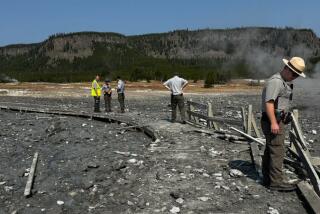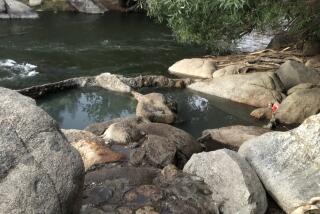Meddling Imperils Geysers’ Plumbing : Geology: Vandals and tourists toss debris down the holes, sometimes altering the activities of the hot springs.
- Share via
YELLOWSTONE NATIONAL PARK, Wyo. — On a recent inspection tour of geyser basins, geologist Rick Hutchinson came upon “the most severe vandalism” in his more than 20 years as custodian of Yellowstone’s 10,000 thermal phenomena.
Into a hot spring at Heart Lake basin, unknown vandals had thrown large boulders, clumps of sod and logs. They even tossed in a live garter snake, killed instantly in the boiling water.
The spring will never recover. The intruding material lowered the water level 3 to 4 inches.
“It’s a superfragile, non-renewable resource that people from all over the world enjoy,” Hutchinson says of the park’s thermal wonders.
Even Old Faithful, the world’s most famous geyser, received its share of debris before park managers fenced it off years ago. But it still keeps erupting every 45 to 100 minutes.
Yellowstone sits atop a hot spot in the Earth’s crust. Surface water trickles down until it reaches underground reserves of magma, or molten rock. It returns to the surface in a dazzling variety of hissing, bubbling, roaring thermal features: geysers, hot springs, fumaroles (steam vents), mud pots.
The park has 200 to 300 geysers, more than any other place. The other countries where they are most common are Iceland and New Zealand.
Geyser fields lie above immense, interlocking underground plumbing systems, superheated caldrons that periodically build up so much pressure that they send plumes of water and steam shooting skyward.
Usually the fields are in areas of volcanic or earthquake activity. Much of Yellowstone occupies the caldera of an enormous volcano that erupted 600,000 years ago. Earthquakes occasionally shake the region.
When they do, the delicate plumbing systems change. Old geysers die and new ones are born. “You don’t get bored,” says Hutchinson. “It’s living geology.”
Nobody was bored the day Pork Chop blew up. The geyser had been spouting continuously for 4 1/2 years, to a height of about 30 feet. Suddenly, on a September day in 1989, it exploded loudly, shot more than 60 feet and threw rocks and debris nearly 200 feet. Since then, it has been a benign hot spring.
Many changes in geyser activity around the world are direct results of human interference.
“The state of the geysers in New Zealand is dismal,” Edwards F. Lloyd, a geologist and geyser expert, said.
In the 1950s, he says, the country had about 150 geysers. Today it has fewer than 20. One major geyser field was lost to a hydroelectric dam. Another succumbed to a geothermal power plant that siphoned away its heat source.
At Rotorua, New Zealand’s last remaining major geyser field lost half of its 12 geysers to wells drilled for hot water to heat homes.
Not until the early 1980s did the government intervene, prohibiting well-drilling within about a mile of active geysers.
Lloyd, who recently retired from the national government after nearly 40 years of geyser-watching, credits New Zealand’s growing environmental movement for helping curb geyser destruction.
In Iceland, the nation that gave geysers their name, geothermal wells from underground hot springs provide heat for more than 80% of the country’s 251,000 people.
Only a fraction of the inexpensive, non-polluting resource has been tapped on the earthquake-prone island in the North Atlantic, says Stefan Arvorsson, a University of Reykjavik geochemist.
Geysir , the country’s most famous geyser, means “gusher” or “spouter” in Icelandic. Its geothermal field was first mentioned in 1294.
Over the centuries, Geysir has had an on-again, off-again life. “Its activity has been quite limited since 1960,” Arvorsson says. “It needs to be stimulated.”
The stimulation comes at 3 p.m. every Saturday, when a ranger pours more than 150 pounds of laundry soap into the geyser’s vent, apparently without harming it.
Geysir obliges with a splendid eruption that shoots water and steam as high as 230 feet for as long as 30 minutes.
But all earthbound geyser action is rather pallid compared to what geysers might do in space.
“We’ve really had to redefine not only the words but the concept of geysers in terms of planetary exploration,” says Susan W. Kieffer of Arizona State University.
Io, one of Jupiter’s large satellites, has volcanic activity that resembles geyser activity on Earth. If Old Faithful erupted under Io’s gravity and atmosphere, it would soar more than 23 miles.
Kieffer and colleagues reported in the journal Science last October about “geyser-like eruptions” on Neptune’s satellite Triton. “Each eruption may last a year or more,” they wrote.
A year on Triton equals 165 years on Earth.
More to Read
Sign up for Essential California
The most important California stories and recommendations in your inbox every morning.
You may occasionally receive promotional content from the Los Angeles Times.










